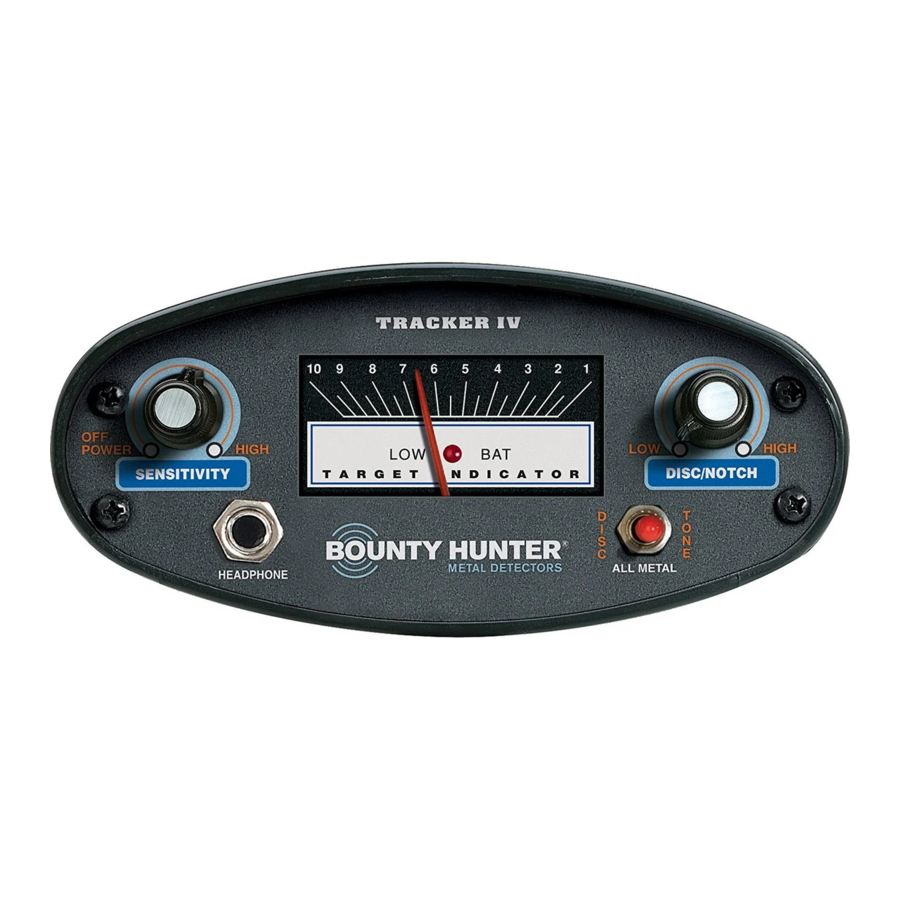
Bounty Hunter Tracker IV, TK4 - Metal Detector Manual
- Owner's manual (17 pages) ,
- Advanced settings (2 pages) ,
- Owner's manual (16 pages)
Advertisement
![]()
Settings
Basic Controls
There are only three adjustable settings: sensitivity, search mode and discrimination.
While the lack of advanced settings might seem limiting to experienced hobbyists, it makes the Tracker IV easy to learn and use.
Sensitivity
Let's start with sensitivity.
The higher the sensitivity, the deeper the detector will be able to "see" a target. Or, to put it another way, the smaller the minimum target size for detection.
There's a problem with higher sensitivity though. The deeper the detector is searching, the more likely it is to be triggered by mineralization in the soil.
Higher sensitivity also makes electromagnetic interference from power lines and outdoor appliances more likely.
For this reason, you may need to use a lower sensitivity to reduce falsing and excessive chatter. Adjusting the sensitivity is as simple as turning the dial on the left of the control panel. The goal is to have the sensitivity as high as possible while rejecting false signals.
Discrimination
There's also a knob to adjust discrimination. This becomes active when the detector is in "Full Discriminate" or "Tone" mode, but is ignored in "All-Metal" mode.
What does discrimination mean though?
In the metal detecting world, discrimination is a detector's ability to ignore unwanted targets. Examples include metals that are often trash items, such as lead and iron.
More advanced machines have notch discrimination using a graphical interface. These allow you to "notch out" certain types of metal you don't want to detect, such as pull tabs or other trash.
The Bounty Hunter Tracker IV just has a single knob for discrimination though. The higher the setting, the more aggressive the discrimination - but there's no option to "notch out" areas while leaving others.
There's no doubt the discrimination knob is a useful feature and is simpler to use than other detectors. But it lacks the flexibility of models such as the Garrett 250 (click here for my full review of this model).
You also need to avoid accidentally discriminating objects you want to find. While a high discrimination allows you to find highly conductive metals without iron signals, such as silver and copper, it may reject potentially valuable metals such as brass, nickel or gold.
For this reason, it's a good idea to take a variety of targets into your garden and practice with the detector. Try to get a feel for which items are rejected at various levels of discrimination.
If this sounds complicated, then don't worry - it's not! You just need practice to find the right discrimination setting. You can also use all-metal mode if you're worried about missing targets.
Search Modes
There are three search modes included with the Tracker IV. These are activated using the switch at the bottom right of the control panel.
- All-Metal - All types of metal are detected in this mode, including aluminum, steel, brass, copper, iron, silver and gold. A single high-pitched beep is emitted as you go over metal. The advantage of all-metal mode is that it provides maximum depth. It's also useful for relic hunting, as some "real" targets may be made from iron.
- Tone - Unlike the other two modes, this mode features two-tone audio with automatic iron rejection. It emits a low or high audio signal depending on the type of metal detected. This mode also respects the discrimination setting.
- Full Discriminate - Most trash items are automatically rejected in this mode. You can adjust the range of discrimination using the discrimination dial. Like All-Metal, this mode only uses a single tone.
Documents / Resources
References
Download manual
Here you can download full pdf version of manual, it may contain additional safety instructions, warranty information, FCC rules, etc.
Download Bounty Hunter Tracker IV, TK4 - Metal Detector Manual
Advertisement















Need help?
Do you have a question about the Tracker IV and is the answer not in the manual?
Questions and answers